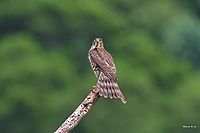Besra
 From Conservapedia
From Conservapedia | Besra | |
|---|---|

| |
| Scientific classification | |
| Kingdom Information | |
| Domain | Eukaryota |
| Kingdom | Animalia |
| Subkingdom | Bilateria |
| Branch | Deuterostomia |
| Phylum Information | |
| Phylum | Chordata |
| Sub-phylum | Vertebrata |
| Infraphylum | Gnathostomata |
| Class Information | |
| Superclass | Tetrapoda |
| Class | Aves |
| Sub-class | Neornithes |
| Infra-class | Neoaves |
| Order Information | |
| Order | Accipitriformes |
| Sub-order | Accipitres |
| Family Information | |
| Superfamily | Accipitroidea |
| Family | Accipitridae |
| Sub-family | Accipitrinae |
| Genus Information | |
| Genus | Accipiter |
| Species Information | |
| Species | A. virgatus |
| Population statistics | |
| Population | >100,000 (2016 est.) |
| Conservation status | Least concern[1] |
The besra (Accipiter virgatus) is a bird of prey in the family Accipitridae, one of many of the genus of Accipiter, or true hawks, and found throughout much of southern and eastern Asia.
Description[edit]
The besra is a medium-sized hawk, about 12.9 inches in length. The top of the bird to the tail is dark gray, with the tail barred in black. The throat to the belly and legs are barred in brown over white, while the sides of the chest are rufus in color. Iris yellow, black beak, yellow feet and legs. Females are slightly larger than males; they, and young birds, are brown rather than gray, with less rufus on the chest.
Subspecies[edit]
- Accipiter virgatus abdulalii; India: Andaman and Nicobar islands
- Accipiter virgatus [affinis or kashmiriensis]; northern India and Nepal, eastward to central China and Indochina
- Accipiter virgatus besra; southern India and Sri Lanka
- Accipiter virgatus confusus; Philippines: Luzon, Mindoro, Negros and Catanduanes islands
- Accipiter virgatus fuscipectus; Taiwan
- Accipiter virgatus nisoides; Myanmar, Thailand and northern Malay Peninsula
- Accipiter virgatus quagga; Philippines: Cebu, Bohol, Leyte, Samar, Siquijor and Mindanao islands
- Accipiter virgatus quinquefasciatus; Indonesia: Flores and Lesser Sundas
- Accipiter virgatus rufotibialis; Indonesia: Borneo Island
- Accipiter virgatus vanbemmeli; Indonesia: Sumatra Island
- Accipiter virgatus virgatus; Indonesia: Java and Bali islands
Range and habitat[edit]
The besra lives in southern and southeastern Asia, from northern India, southern and central China, Indochina and the Indian peninsula to Ceylon, the Malay peninsula, the Little Sunda Islands and the Philippines.
Besras are present in areas characterized by small shrubs whose crown forms are continuous. These birds also live in broad-leaf woods, coniferous forests and wooded areas of all kinds. Outside the nesting season, they have been seen in wetlands, mangroves and agricultural lands, and have settled not far from fish farms. In Sabah (northern Borneo) they can be sighted in clearings along roadsides and in mountain forests. The species has been known to breed within an elevation of 1,800 to 6,000 feet.
Diet[edit]
Besras mainly capture small birds such as bulbuls, thrushes, sparrows, and warblers; the larger females are able to kill partridges, pigeons, quails and woodcocks. Mammals such as flying squirrels, mice and bats are also taken, as well as small reptiles and insects. When they chase prey they fly with quick wingbeats in a manner similar to a turtledove; they are very skilled flyers, able to zigzag or to make twists to avoid an obstacle. The great speed sometimes allows them to catch particularly elusive prey. Due to its speed, skill and endurance, some falconers consider the besra to be one of the most successful animals to hunt with[2].
Reproduction[edit]
Nesting season takes place from March to June, mainly in April and May. The nest, a platform built with pieces of wood, is located within the dense foliage of a tree between 45 and 75 feet above the ground. For this purpose, other trees can also be used that generally grow on the edge of a precipice or overlook a ravine. Nests of corvids are often occupied or usurped.
The brood comprises 3 to 5 eggs of very beautiful appearance, generally are bluish-white in color with spots, marbling and reddish-brown splashes on the widest part of the shell. Both parents collaborate in parental care, but the duration of incubation is unknown.
References[edit]
Categories: [Birds of Prey] [Accipiter Hawks]
↧ Download as ZWI file | Last modified: 02/19/2023 04:08:11 | 8 views
☰ Source: https://www.conservapedia.com/Besra | License: CC BY-SA 3.0
 ZWI signed:
ZWI signed: KSF
KSF